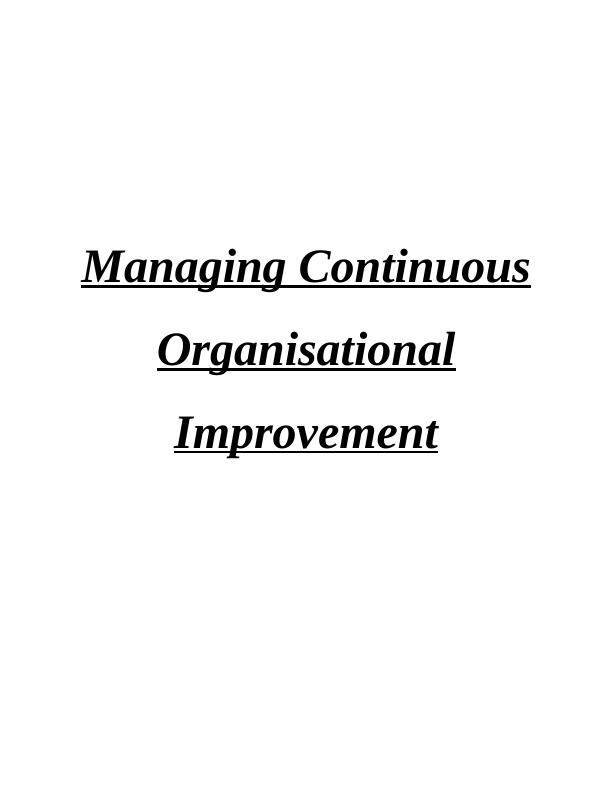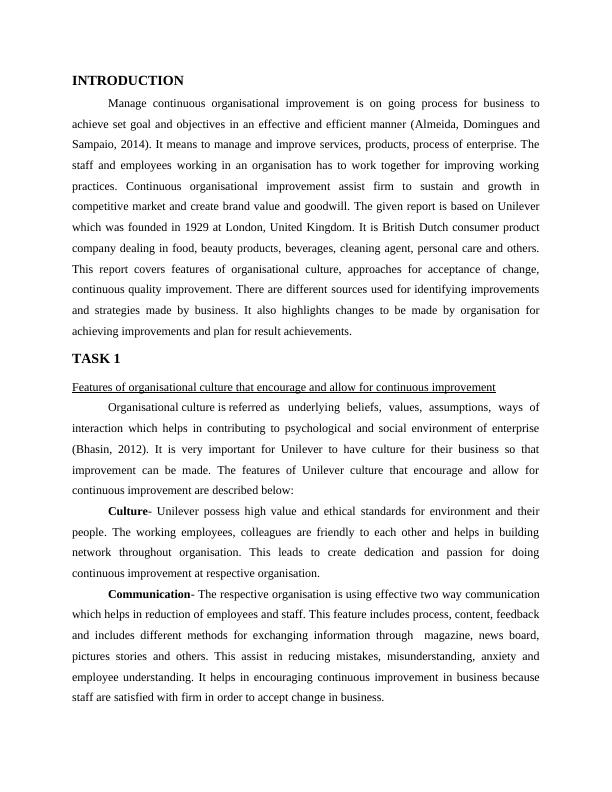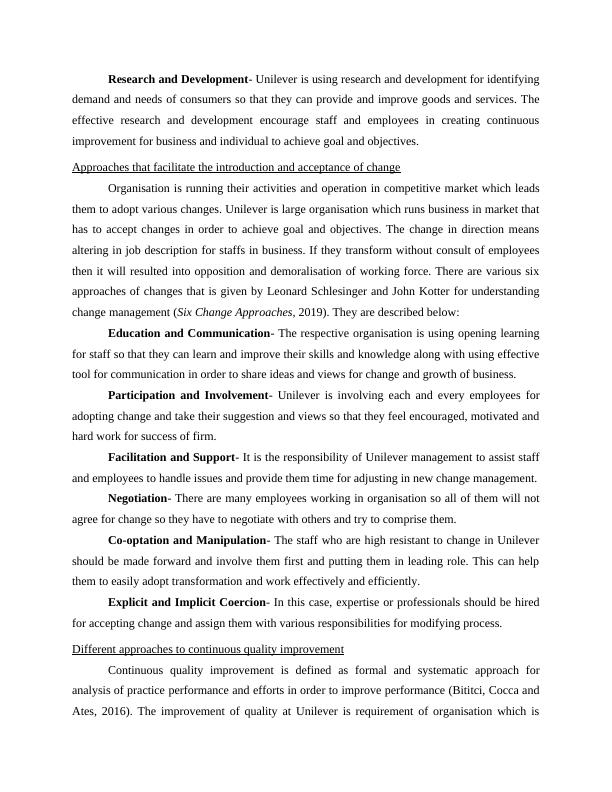Managing Continuous Organisational Improvement
14 Pages4451 Words28 Views
Added on 2023-01-19
About This Document
This report covers features of organisational culture, approaches for acceptance of change, continuous quality improvement, sources of information for identifying improvements, and more.
Managing Continuous Organisational Improvement
Added on 2023-01-19
ShareRelated Documents
Managing Continuous
Organisational
Improvement
Organisational
Improvement

Table of Contents
INTRODUCTION...........................................................................................................................3
TASK 1............................................................................................................................................3
Features of organisational culture that encourage and allow for continuous improvement........3
Approaches that facilitate the introduction and acceptance of change.......................................4
Different approaches to continuous quality improvement..........................................................4
Leadership and management styles facilitate continuous improvement in organisations..........5
Importance of continuous improvement in supporting organisational success..........................5
TASK 2............................................................................................................................................6
Sources of information used by organisations to help identify improvements which are needed
.....................................................................................................................................................6
Meaning of Big Data and evaluate its contribution to improvement strategies..........................6
Review information and identify areas for improvement in the organisation............................7
Potential benefits to a chosen organisation of the proposed changes in activities......................8
TASK 3............................................................................................................................................8
Prepare presentation which explain changes required by organisation to achieve
improvements..............................................................................................................................8
Produce handout for delegates at meeting and evaluate factors for change in organisation.......9
Prepare a plan which will implement the proposed improvements for the organisation............9
Analyses monitoring processes required to ensure the changes lead to the planned
improvements............................................................................................................................10
CONCLUSION..............................................................................................................................11
REFERENCES .............................................................................................................................12
INTRODUCTION...........................................................................................................................3
TASK 1............................................................................................................................................3
Features of organisational culture that encourage and allow for continuous improvement........3
Approaches that facilitate the introduction and acceptance of change.......................................4
Different approaches to continuous quality improvement..........................................................4
Leadership and management styles facilitate continuous improvement in organisations..........5
Importance of continuous improvement in supporting organisational success..........................5
TASK 2............................................................................................................................................6
Sources of information used by organisations to help identify improvements which are needed
.....................................................................................................................................................6
Meaning of Big Data and evaluate its contribution to improvement strategies..........................6
Review information and identify areas for improvement in the organisation............................7
Potential benefits to a chosen organisation of the proposed changes in activities......................8
TASK 3............................................................................................................................................8
Prepare presentation which explain changes required by organisation to achieve
improvements..............................................................................................................................8
Produce handout for delegates at meeting and evaluate factors for change in organisation.......9
Prepare a plan which will implement the proposed improvements for the organisation............9
Analyses monitoring processes required to ensure the changes lead to the planned
improvements............................................................................................................................10
CONCLUSION..............................................................................................................................11
REFERENCES .............................................................................................................................12

INTRODUCTION
Manage continuous organisational improvement is on going process for business to
achieve set goal and objectives in an effective and efficient manner (Almeida, Domingues and
Sampaio, 2014). It means to manage and improve services, products, process of enterprise. The
staff and employees working in an organisation has to work together for improving working
practices. Continuous organisational improvement assist firm to sustain and growth in
competitive market and create brand value and goodwill. The given report is based on Unilever
which was founded in 1929 at London, United Kingdom. It is British Dutch consumer product
company dealing in food, beauty products, beverages, cleaning agent, personal care and others.
This report covers features of organisational culture, approaches for acceptance of change,
continuous quality improvement. There are different sources used for identifying improvements
and strategies made by business. It also highlights changes to be made by organisation for
achieving improvements and plan for result achievements.
TASK 1
Features of organisational culture that encourage and allow for continuous improvement
Organisational culture is referred as underlying beliefs, values, assumptions, ways of
interaction which helps in contributing to psychological and social environment of enterprise
(Bhasin, 2012). It is very important for Unilever to have culture for their business so that
improvement can be made. The features of Unilever culture that encourage and allow for
continuous improvement are described below:
Culture- Unilever possess high value and ethical standards for environment and their
people. The working employees, colleagues are friendly to each other and helps in building
network throughout organisation. This leads to create dedication and passion for doing
continuous improvement at respective organisation.
Communication- The respective organisation is using effective two way communication
which helps in reduction of employees and staff. This feature includes process, content, feedback
and includes different methods for exchanging information through magazine, news board,
pictures stories and others. This assist in reducing mistakes, misunderstanding, anxiety and
employee understanding. It helps in encouraging continuous improvement in business because
staff are satisfied with firm in order to accept change in business.
Manage continuous organisational improvement is on going process for business to
achieve set goal and objectives in an effective and efficient manner (Almeida, Domingues and
Sampaio, 2014). It means to manage and improve services, products, process of enterprise. The
staff and employees working in an organisation has to work together for improving working
practices. Continuous organisational improvement assist firm to sustain and growth in
competitive market and create brand value and goodwill. The given report is based on Unilever
which was founded in 1929 at London, United Kingdom. It is British Dutch consumer product
company dealing in food, beauty products, beverages, cleaning agent, personal care and others.
This report covers features of organisational culture, approaches for acceptance of change,
continuous quality improvement. There are different sources used for identifying improvements
and strategies made by business. It also highlights changes to be made by organisation for
achieving improvements and plan for result achievements.
TASK 1
Features of organisational culture that encourage and allow for continuous improvement
Organisational culture is referred as underlying beliefs, values, assumptions, ways of
interaction which helps in contributing to psychological and social environment of enterprise
(Bhasin, 2012). It is very important for Unilever to have culture for their business so that
improvement can be made. The features of Unilever culture that encourage and allow for
continuous improvement are described below:
Culture- Unilever possess high value and ethical standards for environment and their
people. The working employees, colleagues are friendly to each other and helps in building
network throughout organisation. This leads to create dedication and passion for doing
continuous improvement at respective organisation.
Communication- The respective organisation is using effective two way communication
which helps in reduction of employees and staff. This feature includes process, content, feedback
and includes different methods for exchanging information through magazine, news board,
pictures stories and others. This assist in reducing mistakes, misunderstanding, anxiety and
employee understanding. It helps in encouraging continuous improvement in business because
staff are satisfied with firm in order to accept change in business.

Research and Development- Unilever is using research and development for identifying
demand and needs of consumers so that they can provide and improve goods and services. The
effective research and development encourage staff and employees in creating continuous
improvement for business and individual to achieve goal and objectives.
Approaches that facilitate the introduction and acceptance of change
Organisation is running their activities and operation in competitive market which leads
them to adopt various changes. Unilever is large organisation which runs business in market that
has to accept changes in order to achieve goal and objectives. The change in direction means
altering in job description for staffs in business. If they transform without consult of employees
then it will resulted into opposition and demoralisation of working force. There are various six
approaches of changes that is given by Leonard Schlesinger and John Kotter for understanding
change management (Six Change Approaches, 2019). They are described below:
Education and Communication- The respective organisation is using opening learning
for staff so that they can learn and improve their skills and knowledge along with using effective
tool for communication in order to share ideas and views for change and growth of business.
Participation and Involvement- Unilever is involving each and every employees for
adopting change and take their suggestion and views so that they feel encouraged, motivated and
hard work for success of firm.
Facilitation and Support- It is the responsibility of Unilever management to assist staff
and employees to handle issues and provide them time for adjusting in new change management.
Negotiation- There are many employees working in organisation so all of them will not
agree for change so they have to negotiate with others and try to comprise them.
Co-optation and Manipulation- The staff who are high resistant to change in Unilever
should be made forward and involve them first and putting them in leading role. This can help
them to easily adopt transformation and work effectively and efficiently.
Explicit and Implicit Coercion- In this case, expertise or professionals should be hired
for accepting change and assign them with various responsibilities for modifying process.
Different approaches to continuous quality improvement
Continuous quality improvement is defined as formal and systematic approach for
analysis of practice performance and efforts in order to improve performance (Bititci, Cocca and
Ates, 2016). The improvement of quality at Unilever is requirement of organisation which is
demand and needs of consumers so that they can provide and improve goods and services. The
effective research and development encourage staff and employees in creating continuous
improvement for business and individual to achieve goal and objectives.
Approaches that facilitate the introduction and acceptance of change
Organisation is running their activities and operation in competitive market which leads
them to adopt various changes. Unilever is large organisation which runs business in market that
has to accept changes in order to achieve goal and objectives. The change in direction means
altering in job description for staffs in business. If they transform without consult of employees
then it will resulted into opposition and demoralisation of working force. There are various six
approaches of changes that is given by Leonard Schlesinger and John Kotter for understanding
change management (Six Change Approaches, 2019). They are described below:
Education and Communication- The respective organisation is using opening learning
for staff so that they can learn and improve their skills and knowledge along with using effective
tool for communication in order to share ideas and views for change and growth of business.
Participation and Involvement- Unilever is involving each and every employees for
adopting change and take their suggestion and views so that they feel encouraged, motivated and
hard work for success of firm.
Facilitation and Support- It is the responsibility of Unilever management to assist staff
and employees to handle issues and provide them time for adjusting in new change management.
Negotiation- There are many employees working in organisation so all of them will not
agree for change so they have to negotiate with others and try to comprise them.
Co-optation and Manipulation- The staff who are high resistant to change in Unilever
should be made forward and involve them first and putting them in leading role. This can help
them to easily adopt transformation and work effectively and efficiently.
Explicit and Implicit Coercion- In this case, expertise or professionals should be hired
for accepting change and assign them with various responsibilities for modifying process.
Different approaches to continuous quality improvement
Continuous quality improvement is defined as formal and systematic approach for
analysis of practice performance and efforts in order to improve performance (Bititci, Cocca and
Ates, 2016). The improvement of quality at Unilever is requirement of organisation which is

End of preview
Want to access all the pages? Upload your documents or become a member.
Related Documents
(PDF) Managing Continuous Improvement Processlg...
|13
|4075
|50
Managing Continuous Organisational Improvementlg...
|11
|2777
|217
Managing Continuous Organisational Improvementlg...
|13
|3552
|261
Managing Continuous Organisational Improvement (Doc)lg...
|13
|3818
|97
Managing Continuous Organizational Improvementlg...
|17
|961
|91
(PDF) Continuous improvement philosophy – literature reviewlg...
|12
|3315
|27
